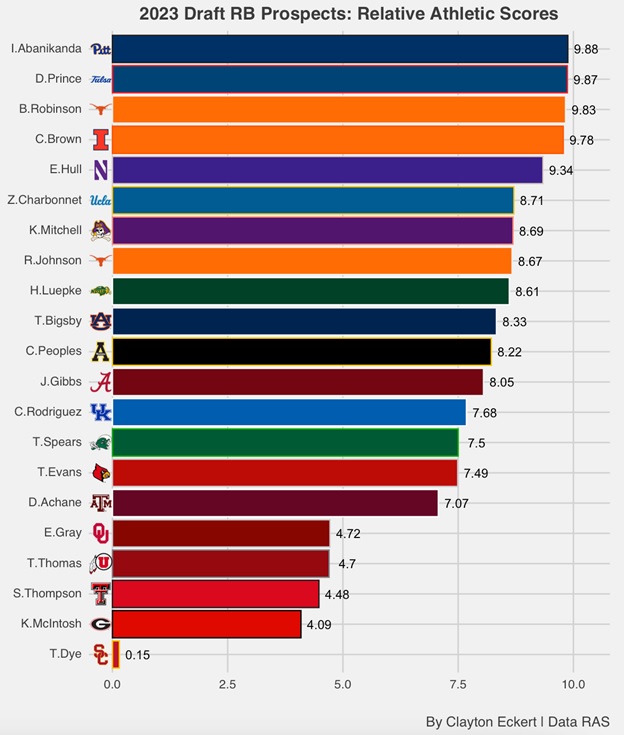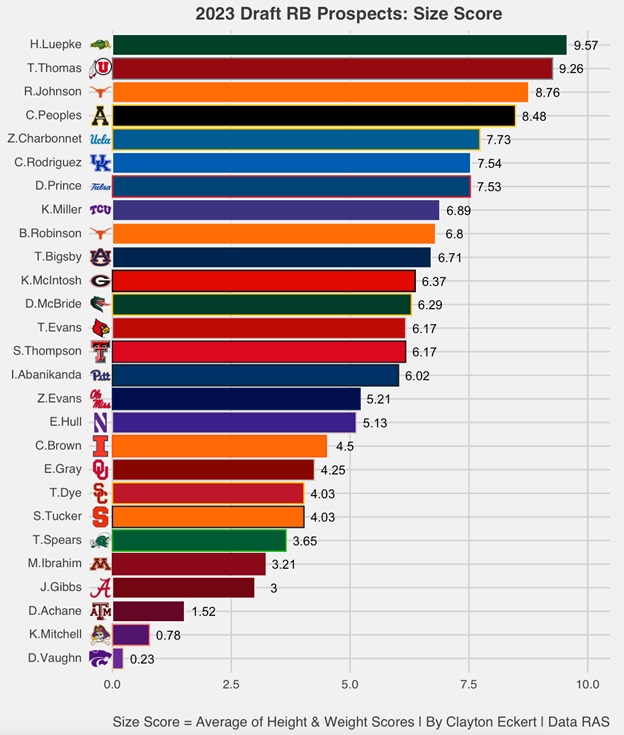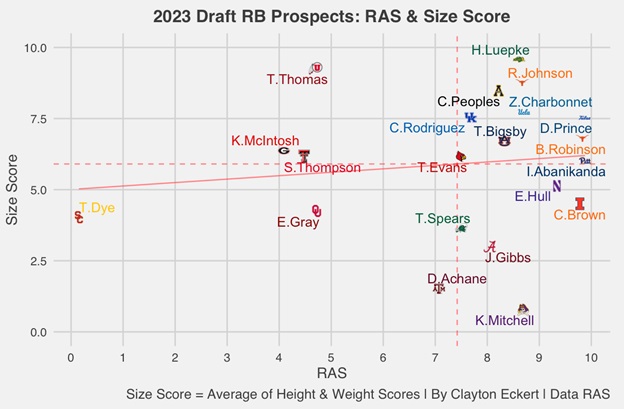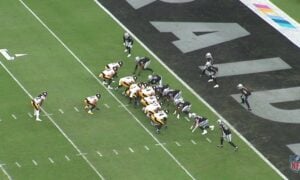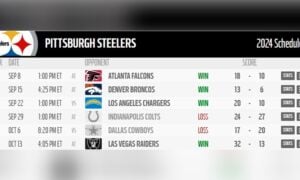Today I wanted to analyze some great data from Kent Lee Platt’s Relative Athletic Scores (RAS) for the running backs. Here is a link to Platt’s website in case you haven’t seen his work. To qualify for a RAS score, a player must have a total of six recorded metrics from any of the following: Height, Weight, 40-yard dash, 20-yard split, 10-yard split, Bench Press, Vertical Jump, Broad Jump, Short Shuttle, and 3-Cone. Players are graded on each in comparison to the positional database since 1987 to get more of a feel of their size, speed, explosion, agility, and total value, giving context to the raw numbers.
The goal of the series is to provide the RAS from Platt, with a bit of my own twist with a size score and visualize it to get a simultaneous view of all the players at their position that participated at the combine. Here are the players that qualified for a RAS (NOTE: Positions are grouped from the Combine results tracker compiled by Dave Bryan and Alex Kozora):
Five prospects have a nine+ RAS, with Pittsburgh’s Israel Abanikanda topping this year’s list (9.88 RAS). He has elite speed and explosion, good size, but no agility testing, with a 41” vertical his best mark and height (5101) his lowest yet acceptable number. Tulsa’s Deneric Prince (9.87 RAS) has elite speed, great explosion, good size, but no agility testing, with a 4.41 40-yard dash his best workout and weight (216) his lowest. Bijan Robinson of Texas (9.83 RAS) has elite speed, great explosion, good size, but no agility testing, with a 2.56 20-yard split his best and height (5110) his lowest (acceptable) result. Chase Brown of Illinois (9.78 RAS) has elite speed and explosion, okay size, but no agility testing, with a 1.5 10-yard split his best test but height (5094) a concern. Northwestern’s Evan Hull (9.34 RAS) has elite speed, great explosion, good agility, and okay size, with a 2.55 20-yard shuttle his best mark and 4.38 shuttle his lowest result.
Seven players land in the eight range, starting with UCLA’s Zach Charbonnet (8.71 RAS). He has great speed and explosion, good size, but poor agility, with a 1.53 10-yard split his best number and a 4.46 shuttle the lowest. East Carolina’s Keaton Mitchell (8.69 RAS) has elite speed and explosion, but very poor size and no agility testing, with a strong 4.37 40-yard dash but historically concerning weight (179) for the position. Roschon Johnson of Texas (8.67 RAS) has great size, good speed, okay explosion, but no agility testing, with a 1.54 10-yard split his best workout and 31.5” vertical the lowest.
Hunter Luepke is viewed by several as a fullback, but also played running back at North Dakota State, with an 8.61 RAS at this position (9.68 at FB) with elite size, good speed, explosion, and agility, with weight (234) his best number and 2.69 20-yard split his lowest. Auburn’s Tank Bigsby (8.33 RAS) has good size and speed, okay explosion, with a 2.6 20-yard split his best mark and 32.5 vertical his lowest workout. Appalachian State’s Camerun Peoples (8.22 RAS) has great size and explosion, good speed, and didn’t qualify in agility, with height (6013) his best result and 4.56 shuttle his lowest number. Alabama’s Jahmyr Gibbs (8.05 RAS) has elite speed, but poor size, didn’t qualify in explosion, and no agility testing, with a strong 4.36 40-yard dash and weight (199) his lowest result.
Four players land in the sevens, starting with Kentucky’s Chris Rodriguez (7.68 RAS). He has good size and speed, but poor explosion and didn’t qualify in agility, with a 2.59 20-yard split his best workout and 906 broad jump the lowest result. Tulane’s Tyjae Spears (7.5 RAS) has elite explosion, great speed, but poor size and agility, with a 39” vertical his best test but 7.27 three-cone a low mark. Texas A&M’s Devon Achane (7.07 RAS) has elite speed, but very poor size, didn’t qualify in explosion and no agility testing, with a historically elite 4.32 40-yard dash but weight (188) a concern for the position. Louisville’s Tiyon Evans (7.49 RAS) has great speed, good size, but didn’t qualify in explosion and no agility testing, with a 1.55 10-yard split his best mark and 30.5 vertical the lowest number.
After a huge dropoff, four players land in the fourth tier. Oklahoma’s Eric Gray (4.72 RAS) has good explosion, okay speed and agility, but poor size, with a 37.5 vertical his highest result but 14 reps on the bench a low mark. Utah’s Tavion Thomas (4.7 RAS) has elite size, but poor speed and explosion and didn’t qualify in agility, with weight (237) that Pittsburgh has drafted at the position, but a historically low 4.69 shuttle. Texas Tech’s SaRodorick Thompson (4.48 RAS) has good size, okay speed and explosion, but very poor agility, with a 1.57 his best mark but historically low 4.7 shuttle. Georgia’s Kenny McIntosh (4.09) has good size and speed, but poor explosion and very poor agility, with a strong 1.51 10-yard split a strength, but historically low agility (4.69 shuttle and 7.69 three-cone).
USC’s Travis Dye is the final player and has a historically low RAS (0.15). His best result is height (5100) with a particularly low 27” vertical in a historically poor workout.
Next, I want to provide more context with a size score using the RAS for the players height and weight, which includes all the Combine invites since all the players are measured:
Luepke (6012, 234) tops this list, as expected, with his position versatility, with only his three-cone (7.03) outside of Pittsburgh’s draft history at running back. Thomas (6003, 237) is the only other prospect with a nine+ size score, important from a Steelers perspective considering their draft history, but his 4.74 40-yard dash is outside their past tendencies, and he didn’t run the three-cone.
Two players have size scores in eight range. Johnson (6003, 225) is the final player that fits the size profile the Steelers have looked for and checks all the athletic boxes he participated in but didn’t bench or do agility testing. Peoples (6013, 217) is close to the mold that Pittsburgh has drafted, fitting well athletically but didn’t bench or participate in the three-cone.
Three players have size scores in the sevens. Charbonnet (6003, 214) misses in weight and his 7.16 three-cone would set a new precedent. Rodriguez (5115, 217) is also close to the mold Pittsburgh has preferred, but has smaller hands (8 5/8”) and didn’t do the three-cone drill. Prince (5116, 216) is close in size as well, pairing this with the second ranked 9.87 RAS, fitting well athletically but didn’t bench or do agility tests.
A big group of eight players land in the sixth tier, starting with TCU’s Kendre Miller (5111, 215), who had 9 3/8” hands and 32 3/8” arms. Robinson (5110, 215) is close to the Steelers’ mold along with the third-ranked 9.83 RAS. But he will be well off the board before Pittsburgh considers a selection at the position and didn’t bench or do agility tests. Bigsby (5115, 210) checks all the past draft thresholds except weight, but he didn’t do agility testing either. McIntosh (6002, 204) misses the mark in weight and three-cone and didn’t bench.
UAB’s DeWayne McBride (5104, 215) had 9 3/8” hands and 30 3/8” arms and close is to the Steelers’ mold. Tiyon Evans (5094, 225) lacks in height but has the weight, though he misses in hand size (8 1/2”) and didn’t bench or do agility tests. Thompson (5114, 207) tied him with a 6.17 size score, a noticeably lighter prospect, also missing the mark with a 7.25 three-cone and didn’t bench. Abanikanda (5101, 216) is closer to the size mold along with the top-ranked 9.88 RAS but has smaller hands (8 1/4”).
Two players land in the fives. Zach Evans of Ole Miss (5111, 202) is a lighter prospect who had 10 1/4” hands and 31 5/8” arms. Hull (5101, 209) is the other, also missing the past weight threshold, but checks every other box along with a 9.34 RAS.
Four players have size scores in the fours, starting with Brown (5094, 209). Another smaller but athletic back (9.78 RAS), he didn’t do agility testing. Gray (5094, 207) also misses past thresholds in the bench and three-cone. Dye (5100, 201) has the height, but he had the lowest ranked and historically low RAS, with a slow 4.82 40-yard dash, 27” vertical, 811 broad jump and didn’t do agility drills. Syracuse’s Sean Tucker (5092, 207) tied him in size score (4.03), pairing this with 9 1/2” hands and 30” arms.
Three players land in the three range: Spears (5095, 201) who also missed the mark with a 7.27 three-cone, Minnesota’s Mohamed Ibrahim (5076, 209), who only measured with 9” hands and 28 5/8” arms, and Gibbs (5091, 199), who had nice speed but didn’t bench or do the agility test.
After a big drop off, we see Achane with a size score in the ones (5084, 188) that is very concerning. He didn’t bench, do the broad, or agility testing.
Two players have historically low size scores of less than one: Mitchell (5077, 179), who had elite speed and explosion but no agility tests, and particularly Kansas State’s Deuce Vaughn (5050, 179), which is extremely concerning.
To wrap up, here is a visual layering the RAS and size score to take it all in:
Luepke is an intriguing prospect with the best balance of both, with a plus-nine size score and above eight RAS. I can’t wait to see how he’s utilized in the NFL. Johnson and Peoples fare very well, with above eight scores in both data points. The former would be the rare and best fit in Pittsburgh if history were to hold up.
Prince has the best size of the +nine RASs, followed by Robinson and Abanikanda, with the latter landing just above the mean in size. The other players that landed above average in both is highlighted by Charbonnet, with Rodriguez, Bigsby, and Tiyon Evans landing much closer to the mean in both. Hull and Brown highlight the group with strong athleticism with nine plus RASs but below the mean size. Thomas lands on the top left with the size of a typical Steelers back. With he lack of need compared to other positions and lack of “perfect fits” of past draft history at the position, I really hope the Steelers pass on drafting a running back.
For those that like the numbers, it’s unfortunate a few players didn’t test fully. It will be interesting to see how the men stack up in the coming weeks when Platt updates the site with the unofficial numbers.
What are your thoughts on the data? Thanks for reading and let me know your thoughts in the comments.


